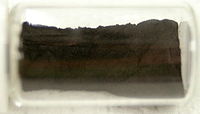Magnesium diboride
 |
|
 |
|
| Identifiers | |
|---|---|
|
12007-25-9 |
|
| 3D model (Jmol) | Interactive image |
| ChemSpider |
13118398 |
| ECHA InfoCard | 100.031.352 |
| PubChem | 15987061 |
|
|
|
|
| Properties | |
| MgB2 | |
| Molar mass | 45.93 g/mol |
| Density | 2.57 g/cm3 |
| Melting point | 830 °C (1,530 °F; 1,100 K) (decomposes) |
| Structure | |
| Hexagonal, hP3 | |
| P6/mmm, No. 191 | |
|
Except where otherwise noted, data are given for materials in their standard state (at 25 °C [77 °F], 100 kPa).
|
|
|
|
|
| Infobox references | |
Magnesium diboride (MgB2) is a simple ionic binary compound that has proven to be an inexpensive and useful superconducting material.
Its superconductivity was discovered by the group of Akimitsu in 2001. Its critical temperature (Tc) of 39 K (−234 °C; −389 °F) is the highest amongst conventional superconductors. This material was first synthesized and its structure confirmed in 1953, but its superconducting properties were not discovered until 2001.
Though generally believed to be a conventional (phonon-mediated) superconductor, it is a rather unusual one. Its electronic structure is such that there exist two types of electrons at the Fermi level with widely differing behaviours, one of them (sigma-bonding) being much more strongly superconducting than the other (pi-bonding). This is at odds with usual theories of phonon-mediated superconductivity which assume that all electrons behave in the same manner. Theoretical understanding of the properties of MgB2 has almost been achieved with two energy gaps. In 2001 it was regarded as behaving more like a metallic than a cuprate superconductor.
Using the BCS theory and the known energy gaps of the pi and sigma bands of electrons, which are 2.2 and 7.1 meV, the pi and sigma bands of electrons have been found to have two different coherence lengths, 51 nm and 13 nm. The corresponding London penetration depths are 33.6 nm and 47.8 nm. This implies that the Ginzburg-Landau parameter is 0.66±0.02 and 3.68 respectively. The first is less than 1/√2 and the second is greater, therefore the first seems to indicate marginal type I superconductivity and the second type II superconductivity.
It has been predicted that when two different bands of electrons yield two quasiparticles, one of which has a coherence length that would indicate type I superconductivity and one of which would indicate type II, then in certain cases, vortices attract at long distances and repel at short distances. In particular, the potential energy between vortices is minimized at a critical distance. As a consequence there is a conjectured new phase called the semi-Meissner state, in which vortices are separated by the critical distance. When the applied flux is too small for the entire superconductor to be filled with a lattice of vortices separated by the critical distance, then there are large regions of type I superconductivity, a Meissner state, separating these domains.
...
Wikipedia
